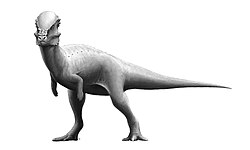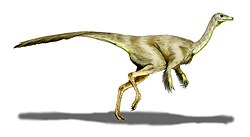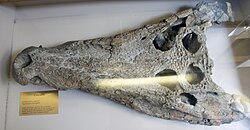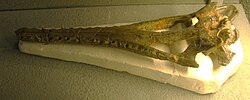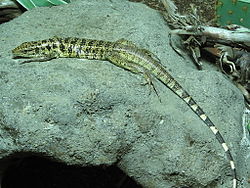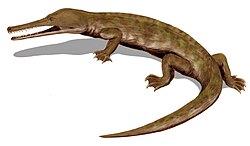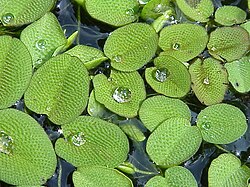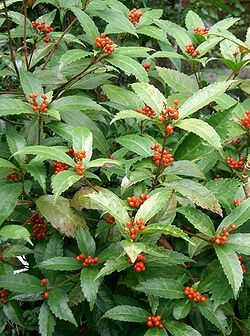Top Qs
Timeline
Chat
Perspective
Paleobiota of the Hell Creek Formation
Fossil flora and fauna of North American site From Wikipedia, the free encyclopedia
Remove ads
This is an overview of the fossil flora and fauna of the Maastrichtian-Danian Hell Creek Formation.
Invertebrates
Summarize
Perspective
Insects
Insects from the groups Diptera, Zygoptera, and possibly Hemiphlebiidae have been unearthed in Hell Creek in amber.[1][2] Fossils found in the Hell Creek Formation and the Fort Union Formation of these insects went extinct during the K-T Event.[3][4][5]
Color key
|
Notes Uncertain or tentative taxa are in small text; |
Molluscs
Remove ads
Amphibians
Summarize
Perspective
Color key
|
Notes Uncertain or tentative taxa are in small text; |
Remove ads
Fish
Summarize
Perspective
Bony fish
Cartilaginous fish
Remove ads
Dinosaurs
Summarize
Perspective
A paleo-population study is one of the most difficult of analyses to conduct in field paleontology. Here is the most recent estimate of the proportions of the eight most common dinosaurian families in the Hell Creek Formation, based on detailed field studies by White, Fastovsky and Sheehan.[33]
- Ceratopsidae 61%
- Hadrosauridae 23%
- Ornithomimidae 5%
- Tyrannosauridae 4%
- Hypsilophodontidae 3%
- Dromaeosauridae 2%
- Pachycephalosauridae 1%
- Ankylosauridae 1%
- Troodontidae 1% (represented only by teeth)

Outcrops sampled by the Hell Creek Project were divided into three sections: lower, middle and upper slices. The top and bottom sections were the focus of the PLoS One report, and within each portion many remains of Triceratops, Edmontosaurus, and Tyrannosaurus were found. Triceratops was the most common in each section, but, surprisingly, Tyrannosaurus was just as common, if not slightly more common, than the hadrosaur Edmontosaurus. In the upper Hell Creek section, for example, the census included twenty two Triceratops, five Tyrannosaurus, and five Edmontosaurus.
The dinosaurs Thescelosaurus, Ornithomimus, Pachycephalosaurus and Ankylosaurus were also included in the breakdown, but were relatively rare. Other dinosaurs, such as Sphaerotholus, Denversaurus, Torosaurus, Struthiomimus, Acheroraptor, Dakotaraptor, Pectinodon, Richardoestesia, Paronychodon, Anzu, Leptorhynchos and Troodon (more likely Pectinodon), were reported as being rare and are not included in the breakdown.
The dinosaur collections made over the past decade during the Hell Creek Project yielded new information from an improved genus-level collecting schema and robust data set that revealed relative dinosaur abundances that were unexpected, and ontogenetic age classes previously considered rare. We recognize a much higher percentage of Tyrannosaurus than previous surveys. Tyrannosaurus equals Edmontosaurus in U3 and in L3 comprises a greater percentage of the large dinosaur fauna as the second-most abundant taxon after Triceratops, followed by Edmontosaurus. This is surprisingly consistent in (1) the two major lag deposits (MOR loc. HC-530 and HC-312) in the Apex sandstone and Jen-rex sand where individual bones were counted and (2) in two thirds of the formation reflected in L3 and U3 records of dinosaur skeletons only.
Triceratops is by far the most common dinosaur at 40% (n = 72), Tyrannosaurus is second at 24% (n = 44), Edmontosaurus is third at 20% (n = 36), followed by Thescelosaurus at 8% (n = 15), Ornithomimus at 5% (n = 9), and Pachycephalosaurus and Ankylosaurus both at 1% (n = 2) are relatively rare.
Fossil footprints of dinosaurs from the Hell Creek Formation are very rare. As of 2017, there is only one find of a possible Tyrannosaurus rex footprint, dating from 2007 and described a year later.[34] A trackway made by mid-sized theropod, possibly a small tyrannosaurid individual, was discovered in South Dakota in 1997, and in 2014 these footprints were named Wakinyantanka styxi.[35]
Ornithischians
Ankylosaurs
Indeterminate nodosaur remains have been unearthed in the Hell Creek Formation and other nearby areas.[36][37]
Pachycephalosaurs
An undescribed and unnamed pachycephalosaur is present in North Dakota.[41] Pachycephalosaur remains have been unearthed in Montana as in the case of Platytholus and the now invalid genus Stenotholus kohleri, which is now a junior synonym of Pachycephalosaurus.[42] Dracorex hogwartsia is agreed by paleontologists to be an ontogimorph of either Pachycephalosaurus or Stygimoloch, while the synonymy of Stygimoloch spinifer with Pachycephlosaurus remains uncertain due to difference in stratigraphic level.[43][44][45]
Ceratopsians
Indeterminate ceratopsid teeth and some identifiable bones from Triceratops can be extremely common.[51][52][53][54][55] 8.31% of all vertebrate remains from the Hell Creek Formation are unassigned ceratopsids.[11] In 2012, a new unidentified species of chasmosaur ceratopsian with noticeable differences from Triceratops was unearthed in South Dakota by a fossil hunter named John Carter.[56][57][58]
Color key
|
Notes Uncertain or tentative taxa are in small text; |
Ornithopods and relatives
Indeterminate hadrosaurid remains are very common in the Hell Creek Formation.[8] Fossils of indeterminate lambeosaurs have been unearthed in Hell Creek, specifically in South Dakota and Montana.[66][67][68][69][70][71]
Theropods
Theropod tracks have been found in South Dakota.[46] A trackway from South Dakota, named Wakinyantanka, was made by a mid-sized theropod with three slender toes, possibly a small tyrannosaurid.[35] A second footprint that may have been made by a specimen of Tyrannosaurus was first reported in 2007 by British paleontologist Phil Manning, from the Hell Creek Formation of Montana.[82] This second track measures 72 centimeters (28 in) long, shorter than the track described by Lockley and Hunt. Whether or not the track was made by Tyrannosaurus is unclear, though Tyrannosaurus is the only large theropod known to have existed in the Hell Creek Formation, though in past albertosaurine remains have described here but its most likely that they are the remains of Tyrannosaurus rex.[83][84] Theropod remains are very common in Hell Creek, some of which belong to indeterminate species on maniraptorans.[85]
Alvarezsaurs
Tyrannosaurids
Ornithomimosaurs
Ornithomimid remains are not uncommon in the Hell Creek Formation.[8] Fifteen specimens from the Hell Creek Formation are undetermined ornithomimids[11]
Color key
|
Notes Uncertain or tentative taxa are in small text; |
Oviraptorosaurs
Oviraptorosaur fossils have been found at the Hell Creek Formation for many years, most notably from isolated elements until the discovery of Anzu. In the past, oviraptorosaur fossils found were thought to have belonged to Leptorhynchos, Caenagnathus, Chirostenotes, and Elmisaurus.[38][91][92][93][94][95] In 2016, an undescribed large-bodied caenagnathid was unearthed in Montana.[96]
Color key
|
Notes Uncertain or tentative taxa are in small text; |
Eumaniraptorans
Historically, numerous teeth have been attributed to various dromaeosaurid and troodontid taxa with known body fossils from only older formations, including Saurornithoides, Zapsalis, Dromaeosaurus, Saurornitholestes, and Troodon. However, in a 2013 study, Evans et al. concluded that there is little evidence for more than a single dromaeosaurid taxon, Acheroraptor, in the Hell Creek-Lance assemblages, which would render these taxa invalid for this formation. This was seemingly disproven in 2015, when DePalma et al., described the new genus Dakotaraptor, a large species of dromaeosaur.[98] However, Dakotaraptor’s validity has been called into question since, as the holotype may be a chimeric assemblage of various non-dromaeosaurid coelurosaurians.[99] Fossilized teeth of various troodontids and coelurosaurs are common throughout the Hell Creek Formation; the best known examples include Paronychodon, Pectinodon and Richardoestesia, respectively. Teeth belonging to possible intermediate species of Dromaeosaurus[100] and Saurornitholestes[101] have been unearthed at the Hell Creek Formation and the nearby Lance Formation.
Remove ads
Pterosaurs
Undescribed pterosaur remains were reported from North Dakota.[115] Undescribed pteranodontian specimen has also been mentioned in the supplementary material of Longrich et al. (2018).[116]
Remove ads
Crocodylomorphs
Color key
|
Notes Uncertain or tentative taxa are in small text; |
Remove ads
Turtles
Summarize
Perspective
Color key
|
Notes Uncertain or tentative taxa are in small text; |
Remove ads
Squamata
Summarize
Perspective
Color key
|
Notes Uncertain or tentative taxa are in small text; |
Remove ads
Choristoderans
Color key
|
Notes Uncertain or tentative taxa are in small text; |
Mammals
Summarize
Perspective
Multituberculates
Color key
|
Notes Uncertain or tentative taxa are in small text; |
Metatherians
Color key
|
Notes Uncertain or tentative taxa are in small text; |
Eutherians
Color key
|
Notes Uncertain or tentative taxa are in small text; |
Remove ads
Flora
Summarize
Perspective
The Hell Creek Formation was a low floodplain at the time before the sea retreated, and in the wet ground of the dense woodland, the diversity of angiosperms and conifers were present. A diversity of herbaceous flowering plants, ferns and moss grew in the forest understory. On the exposed point bars of large river systems, there were shrubs and vines. The evidence of the forested environment is supported by petrified wood, rooted gley paleosols,[138] and ubiquitous tree leaves. The presence of the simple and lobed leaves, combined with a high dicot diversity, extinct cycadeoid Nilssoniocladus, Ginkgo, many types of monocots, and several types of conifers is different from any modern plant community. There are numerous types of leaves, seeds, flowers and other structures from Angiosperms, or flowering plants. The Hell Creek Formation of this layer contains over 300 tablets, of which angiosperms are the most diverse and dominant flora of the population, about 90 percent, followed by about 5% of conifers, 4% of ferns, and others. Compared to today Hell Creek's flora which is prairie, then Hell Creek's flora was hardwood forest mixed with deciduous and evergreen forest. In sharp contrast to the Great Plains today, the presence of some thermophilous taxa such as palm trees and gingers meant the climate was warmer and wetter then.

The plants of the Hell Creek Formation generally represent angiosperm-dominated riparian forests of variable diversity, depending on stratigraphic position and sedimentary environment. There appears to be floral transitions visible on a stratigraphic range from the lower to the upper Hell Creek Formation. For this reason, Kirk Johnson and Leo Hickey divided it into five zones and described them as HCIa, HCIb, HCIIa, HCIIb, and HCIII as a reflection of floral change through time.[139] For example, the HCIa zone is dominated by "Dryophyllum" subfalcatum, Leepierceia preartocarpoides, "Vitis" stantonii, and "Celastrus" taurenensis, and is located 55 to 105 meters below the K-Pg boundary layer. Although the HCIb zone is a very thin layer, about 5 meters of rock, it bears unusually high diversity of herbaceous and shrubby plants, including Urticaceae, Ranunculaceae, Rosaceae, and Cannabaceae.[140][141]

There is evidence of transitional floras in the middle of the Hell Creek Formation as shown by HCII and HCIII zones. The HCII flora represents a transitional period where taxa from the lower Hell Creek are replaced by the HCIII flora. The diversity of the HCIII zone is very high, and its composition is more uniform than that of HCII, many of which were rare or absent from the zones below, and some others that used to be common below became rarer in the HCIII zone. These forms include Elatides longifolia, "Dryophyllum" tennessensis, Liriodendrites bradacii, and many members of the Laurales including Bisonia niemii, "Ficus" planicostata, and Marmarthia trivialis, while "Celastrus" taurenensis, Leepierceia preartocarpoides, and many cupressaceous conifers became rarer. This phenomenon suggests that the global temperature was warming during the last 300,000-500,000 years of the Cretaceous period.[140][141][142][143]
There is no evidence of fern prairie in the Hell Creek Formation.[144] However, there was high angiosperm diversity — common plane trees, "Dryophyllum" subfalcatum, Leepierceia preartocarpoides, and sabal palms — along with extinct cycadeoid Nilssoniocladus, Ginkgo, araucariaceous, Taxodiaceous, and cupressaceous conifers. This represents the mixed deciduous and evergreen broad-leaved forest of the Hell Creek landscape. The nature of these forests is uncertain because Johnson found that the majority of the angiosperm and conifer genera are now extinct. He also believes that, very roughly 80% of the terrestrial plant taxa died out in what is now Great Plains at the K-Pg boundary. On other hand, there is a great increase in the abundance of fossil fern spores in the two centimeters of rock that directly overlies the impact fallout layer (the famous K-Pg boundary layer). This increase in fern spore abundance is commonly referred as "the fern spike" (meaning that if the abundance of spores as a function of stratigraphic position were plotted out, the graph would show a spike just above the impact fallout layer).
Many of the modern plant affinities in the Hell Creek Formation (e.g., those with the prefix "aff." or with quotes around the genus name) may not in reality belong to these genera; instead they could be entirely different plants that resemble modern genera. Therefore, there is some question regarding whether the modern Ficus or Juglans, as two examples, actually lived in the Late Cretaceous.
Compared to the rich Hell Creek Formation fossil plant localities of the Dakotas, relatively few plant specimens have been collected from Montana. A few taxa were collected at Brownie Butte Montana by Shoemaker, but most plants were collected from North Dakota (Slope County) and from South Dakota. Among the localities, the Mud Buttes, located in Bowman County, North Dakota, is probably the richest megaflora assemblage known and the most diverse leaf quarry from the Hell Creek Formation.[141] "TYPE" after the binomial means that it is represented by a type specimen found in the Yale-Peabody Museum collections. "YPM" is the prefix for the Yale-Peabody Museum specimen number; "DMNH" is for the Denver Museum of Nature & Science; "USNM" is for Smithsonian National Museum of Natural History; and so on. The majority of Hell Creek megafloral specimens are collected at the Denver Museum of Nature & Science.
Overview (from Johnson, 2002)
302 plant morphotypes based on leaf only, including:
- 1 bryophyte (mosses and liverworts)
- 11 ferns
- 1 sphenopsid
- 10 conifers
- 1 ginkgo (uncommon)
- 278 angiosperms (roughly 92% of all taxa found)
Paleoflora
Color key
|
Notes Uncertain or tentative taxa are in small text; |
Liverworts
Ferns
Cycadophytes
Ginkgoales
Conifers
Angiosperms
Palynology
Remove ads
See also
- List of fossil sites (with link directory)
- Lists of dinosaur-bearing stratigraphic units
- Paleobiota of the Morrison Formation
- Lance fauna
- Cretaceous-Paleogene formations
- Tremp Formation, Spain
- Tremp Formation, Spain
- Lefipán Formation, Argentina
- Lopez de Bertodano Formation, Antarctica
References
External links
Wikiwand - on
Seamless Wikipedia browsing. On steroids.
Remove ads






